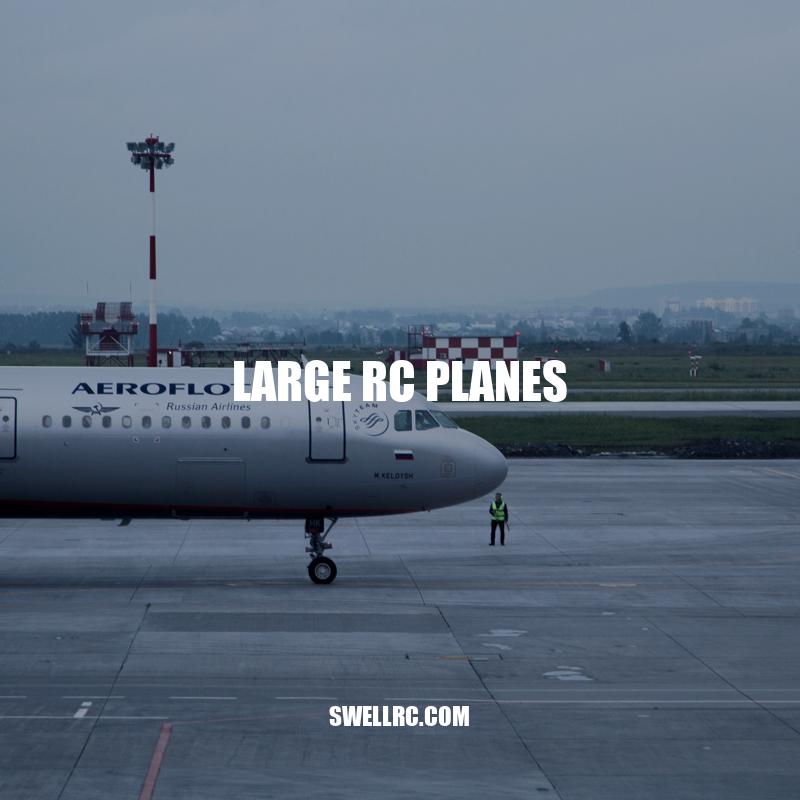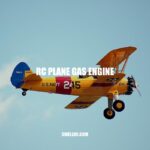Unleashing the Thrills: Exploring Large RC Planes
Large RC planes have revolutionized the world of remote-controlled aircraft. These planes are bigger in size, and they come with many advanced features that make them the perfect hobby for aviation enthusiasts. Remote-controlled planes have become increasingly popular, but large RC planes have gathered a significant following. These planes come in various sizes, ranging from a few feet to nearly 10 feet in length, and they are built to perform extraordinary stunts and maneuvers. Large RC planes are not just entertaining but also educational. They help enthusiasts enhance their flying skills while providing an in-depth understanding of the mechanical workings of a plane. With that said, let’s take a closer look at what makes large RC planes so appealing, and why they are considered to be the ultimate remote-control flying experience.
Advantages of Large RC Planes
Large RC planes offer a unique opportunity to experience aviation in a way that is usually reserved for trained pilots. Here are some of the benefits of owning large RC planes:
- Provides a realistic flying experience
- Improves hand-eye coordination and depth perception
- Offers a fun and rewarding hobby
- Comes in different designs and models
- Can enhance knowledge of planes’ mechanics
One of the best places to buy large RC planes is through online retailers like Horizon Hobby. The website has a broad selection of planes, parts, and accessories that allow enthusiasts to customize their planes according to their preferences. Additionally, it is an excellent resource for valuable information on how to build, customize, and fly your RC planes safely. There are also several forums and online communities that cater to RC enthusiasts. These include RC groups and RC Universe, where members share tips, tricks, and experiences with others. Another useful site is Flite Test, which offers free content for RC hobbyists, including video tutorials, forums, and articles.
Are bigger RC planes easier to fly?
When it comes to remote controlled (RC) planes, size does matter, but not in the way you might think. While a larger plane may seem like it would be easier to control and more stable in the air, the opposite is often true. Heavy planes require more speed and momentum to keep them aloft, and they can be quicker to stall or snap roll. In addition, a heavier plane may not respond well to radio commands, making it more difficult to control.
But weight isn’t the only factor that affects the ease of flying an RC plane. Motors, batteries, cameras, and other gear can also add weight to the plane, making it even more cumbersome in the air. These extra accessories can also make the plane harder to launch, more likely to roll over during takeoff, and require a faster landing speed.
So while a larger RC plane may look impressive and be more powerful, it’s not necessarily easier to fly. In fact, a smaller and lighter plane may be more maneuverable and responsive, allowing for easier control and a smoother flight experience. Ultimately, the best size for an RC plane depends on the pilot’s skill level and the type of flying they want to do.
Types of Large RC Planes
Large RC planes come in various shapes and sizes, from vintage planes to modern jets. Below are some of the most popular types of large RC planes:
| Model | Description |
|---|---|
| P-51 Mustang | A classic American WWII fighter plane that is both fast and agile. |
| Spitfire | A British fighter plane from the WWII era that is renowned for its speed and maneuverability. |
| F-16 Fighting Falcon | A modern all-purpose fighter jet that is perfect for those looking for speed and precision. |
| F-22 Raptor | A cutting edge stealth fighter that boasts unique design features like thrust vectoring. |
Aside from these popular models, there are other types of large RC planes, including biplanes, gliders, helicopters, and scale models. Some interesting facts about large RC planes include:
- The first RC planes were developed in the 1930s, but the hobby did not become popular until the 1960s.
- The largest RC plane ever flown had a wingspan of over 45 feet and weighed over 380 pounds.
- Some RC planes can fly as fast as 400mph, while others can stay airborne for over 24 hours.
For those who are interested in getting started with the hobby, there are various kits available online, such as the Great Planes Extra 300SP ARTF, which provides everything you need to get started, including a pre-built plane, transmitter, and other necessary accessories.
What are some of the largest RC airplanes?
RC airplanes have come a long way in terms of size and capabilities. Today, hobbyists and enthusiasts can enjoy flying massive model airplanes with wingspans that rival some small aircraft. Let’s take a look at some of the largest RC airplanes out there!
First on our list is the B-52 Stratofortress. This scale replica of the iconic bomber has a wingspan of over 23 feet and is powered by eight turbine engines. It’s an impressive sight to see in the air!
Next up is the RC L-39 Albatros, a model of the jet training aircraft used by many air forces around the world. This model boasts an impressive wingspan of 20 feet and is powered by two turbines.
The C-17 Globemaster III is another massive RC airplane. This cargo aircraft replica has a wingspan of 17 feet and can be powered by either two or four turbines, depending on the model.
The Boeing 747 is a classic passenger jet that has been scaled down to RC size. With a wingspan of 18 feet and weighing in at over 150 pounds, this model requires a lot of skill and experience to fly.
Finally, we have the RC Antonov An-225 Mriya. This is the largest RC airplane in the world, with a staggering wingspan of over 28 feet! It’s an awe-inspiring model that is sure to turn heads wherever it goes.
These are just some of the largest RC airplanes out there. With the advancements in technology, who knows how big they’ll get in the future!
Building & Flying Large RC Planes
Building and flying large RC planes require skill, patience, and practice. Here are some tips to help you get started:
- Choose an appropriate flying area: Large open fields or empty parking lots are excellent choices for flying RC planes.
- Ensure your plane is in good condition: Inspect your plane before each flight, checking for any damage and ensuring that all parts are functioning correctly.
- Perform a pre-flight check: Check your plane’s battery, radio, and control surfaces before flying.
- Follow basic safety guidelines: Wear protective gear like eyewear and earplugs when flying, keep spectators a safe distance away, and fly in good weather conditions.
- Start with a trainer plane: If you are new to the hobby, start with a basic trainer plane that is easy to fly and stable in the air.
- Practice flying with a simulator: Many online simulators can help you practice flying RC planes before taking your plane to the air.
Aside from these tips, there are various resources available online to help you get started with building, flying, and maintaining your RC plane. Websites like RC Universe, RC Groups, and RC-Flight-Deck offer forums, tutorials, and information on everything RC-related. There are also various products available, such as RC flight simulators like RealFlight and Phoenix RC, which can help you practice flying your RC plane before heading out to the field. With time and practice, you can master the art of building and flying your large RC planes.
Maintenance and Repairs of Large RC Planes
Regular maintenance and periodic repairs are essential to keep your large RC plane in good condition. Here are some tips on how to take care of your RC plane:
- Clean your plane after every flight: Use a soft, dry cloth to remove any dirt and debris from the plane’s surface.
- Check battery life: Inspect the battery before and after using it to ensure it is not damaged and operates normally.
- Inspect the mechanical parts: Check the mechanical parts of the plane for any wear or damage.
- Check the electronics: Inspect the electronics to ensure that they are functioning correctly, and all wires are securely connected.
- Use genuine parts: When performing repairs, use only genuine parts recommended by the manufacturer.
- Store your plane in a cool, dry place: Protect your plane from moisture, dust, and high temperatures. Use a suitable cover or a storage case to store your RC plane safely.
To keep up with the latest news, technology updates, and upcoming events, enthusiasts can join RC communities, such as online forums and social media groups. These communities offer useful information, tutorials, and advice on how to maintain and repair RC planes. Some popular RC communities include RC Universe, RC Groups, and RC-Flight-Deck.
For additional support and resources, manufacturers often provide manuals and documentation on their products’ maintenance and repairs. Large RC plane enthusiasts can also opt to purchase maintenance and repair kits that contain spare parts and tools for repairing their planes.
By following these simple maintenance and repair guidelines, you can keep your large RC plane in top condition, ensuring that you have a safe and enjoyable flying experience.
How do you store a large RC plane?
Storing a large RC plane can seem like a daunting task, but with proper preparation and care, you can ensure your plane stays safe and ready to fly whenever you want to take it out. Here are some tips for how to store a large RC plane:
1. Clean and dry your plane: Before storing your plane, make sure to clean it thoroughly. Use a soft cloth to wipe away any dirt or debris, and make sure the plane is completely dry to prevent any moisture from causing damage.
2. Disassemble your plane: If possible, disassemble your plane before storing it. This will help prevent any parts from becoming damaged or warped during storage. Make sure to keep all parts organized and labeled so you can easily put them back together when it’s time to fly again.
3. Choose a proper storage location: Ideally, you should store your plane in a cool, dry place that is free from dust and other debris. A garage, basement, or spare room can be a good option. You can also use a storage case or bag specifically designed for RC planes to help protect your plane from damage.
4. Cover your plane: To keep your plane clean and dust-free, consider covering it with a cloth or plastic wrap. This can also help protect it from scratches and other minor damage.
5. Check on your plane regularly: While your plane is in storage, make sure to check on it periodically. This can help you catch any potential problems early on, such as moisture buildup or damage.
Overall, storing a large RC plane doesn’t have to be a hassle. By taking proper care and following these tips, you can ensure your plane stays in great condition and is always ready for your next flight.
Conclusion
In conclusion, Large RC planes offer a unique and exciting experience for remote-control enthusiasts of all skill levels. The planes come in different shapes, sizes, and designs, making it easy for enthusiasts to find their perfect model. Building and flying an RC plane requires effort and dedication, but with practice, anyone can learn and master the art.
Whether you are interested in aerobatic flights or high-speed planes, there is always an RC plane to suit your preferences. The planes also provide an excellent opportunity to develop your coordination, precision, and craftsmanship skills.
If you are new to RC planes, it is essential to start with a beginner model with minimum features. This will give you an opportunity to learn the basics of flying and familiarize yourself with the plane’s mechanics before moving on to more advanced models.
Finally, always remember to maintain and regularly inspect your RC planes to ensure they are safe and last for a long time. RC communities and manufacturer’s manuals are excellent resources for maintenance tips and guidelines.
In conclusion, large RC planes are a fun and rewarding hobby, providing an excellent opportunity to explore and learn about the world of remote-control flying. With the right skills, dedication, and passion, you can enjoy the thrill of flying and explore the skies like a real pilot.



